M1 polarization enhances the antitumor activity of chimeric antigen receptor macrophages in solid tumors
- PMID: 36978075
- PMCID: PMC10044396
- DOI: 10.1186/s12967-023-04061-2
M1 polarization enhances the antitumor activity of chimeric antigen receptor macrophages in solid tumors
Abstract
Background: Chimeric antigen receptor macrophage (CAR-M) therapy is a novel cancer immunotherapy approach that integrates CAR structure and macrophage functions. CAR-M therapy has shown unique and impressive antitumor effects in immunotherapy for solid tumors. However, the polarization state of macrophages can affect the antitumor effect of CAR-M. We hypothesized that the antitumor activity of CAR-Ms may be further improved after inducing M1-type polarization.
Methods: In this report, we constructed a novel HER2-targeting CAR-M, which was composed of humanized anti-HER2 scFv, CD28 hinge region and FcγRI transmembrane domain and intracellular domain. Phagocytosis, tumor-killing capacities, and cytokine release of CAR-Ms were detected with or without M1-polarization pretreatment. Several syngeneic tumor models were used to monitor the in vivo antitumor activity of M1-polarized CAR-Ms.
Results: After polarization with LPS combined with interferon-γ in vitro, we found that the phagocytic and tumor-killing capacities of CAR-Ms against target cells were significantly enhanced. The expression of costimulatory molecules and proinflammatory cytokines was also significantly increased after polarization. By establishing several syngeneic tumor models in vivo, we also demonstrated that infusing polarized M1-type CAR-Ms could effectively suppress tumor progression and prolong the survival of tumor-bearing mice with enhanced cytotoxicity.
Conclusions: We demonstrated that our novel CAR-M can effectively eliminate HER2-positive tumor cells both in vitro and in vivo, and M1 polarization significantly enhanced the antitumor ability of CAR-M, resulting in a stronger therapeutic effect in solid cancer immunotherapy.
Keywords: CAR-M; Cancer immunotherapy; Chimeric antigen receptor; HER2; M1 polarization; Macrophages.
© 2023. The Author(s).
Conflict of interest statement
The authors declare that they have no competing interests.
Figures
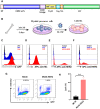
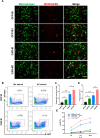
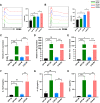
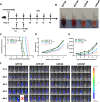

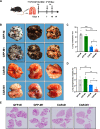
Similar articles
-
Silencing of SIRPα enhances the antitumor efficacy of CAR-M in solid tumors.Cell Mol Immunol. 2024 Nov;21(11):1335-1349. doi: 10.1038/s41423-024-01220-3. Epub 2024 Oct 8. Cell Mol Immunol. 2024. PMID: 39379603 Free PMC article.
-
An engineered α1β1 integrin-mediated FcγRI signaling component to control enhanced CAR macrophage activation and phagocytosis.J Control Release. 2025 Jan 10;377:689-703. doi: 10.1016/j.jconrel.2024.11.064. Epub 2024 Dec 2. J Control Release. 2025. PMID: 39617174
-
The application of HER2 and CD47 CAR-macrophage in ovarian cancer.J Transl Med. 2023 Sep 22;21(1):654. doi: 10.1186/s12967-023-04479-8. J Transl Med. 2023. PMID: 37740183 Free PMC article.
-
Manipulating macrophage polarization in cancer patients: From nanoparticles to human chimeric antigen receptor macrophages.Biochim Biophys Acta Rev Cancer. 2021 Aug;1876(1):188547. doi: 10.1016/j.bbcan.2021.188547. Epub 2021 Apr 29. Biochim Biophys Acta Rev Cancer. 2021. PMID: 33932561 Review.
-
CAR race to cancer immunotherapy: from CAR T, CAR NK to CAR macrophage therapy.J Exp Clin Cancer Res. 2022 Mar 31;41(1):119. doi: 10.1186/s13046-022-02327-z. J Exp Clin Cancer Res. 2022. PMID: 35361234 Free PMC article. Review.
Cited by
-
M1 macrophages as promising agents for cell therapy of endometriosis.Heliyon. 2024 Aug 14;10(16):e36340. doi: 10.1016/j.heliyon.2024.e36340. eCollection 2024 Aug 30. Heliyon. 2024. PMID: 39253270 Free PMC article.
-
Phagocytosis Checkpoints in Glioblastoma: CD47 and Beyond.Curr Issues Mol Biol. 2024 Jul 23;46(8):7795-7811. doi: 10.3390/cimb46080462. Curr Issues Mol Biol. 2024. PMID: 39194679 Free PMC article. Review.
-
Selective loss of Y chromosomes in lung adenocarcinoma modulates the tumor immune environment through cancer/testis antigens.bioRxiv [Preprint]. 2024 Sep 22:2024.09.19.613876. doi: 10.1101/2024.09.19.613876. bioRxiv. 2024. PMID: 39345481 Free PMC article. Preprint.
-
Emerging Innate Immune Cells in Cancer Immunotherapy: Promises and Challenges.BioDrugs. 2024 Jul;38(4):499-509. doi: 10.1007/s40259-024-00657-2. Epub 2024 May 3. BioDrugs. 2024. PMID: 38700835 Free PMC article. Review.
-
DNA origami assembled spheroid for evaluating cytotoxicity and infiltration of chimeric antigen receptor macrophage (CAR-M).Commun Biol. 2024 Oct 11;7(1):1302. doi: 10.1038/s42003-024-07009-4. Commun Biol. 2024. PMID: 39390143 Free PMC article.
References
Publication types
MeSH terms
Substances
LinkOut - more resources
Full Text Sources
Medical
Research Materials
Miscellaneous

